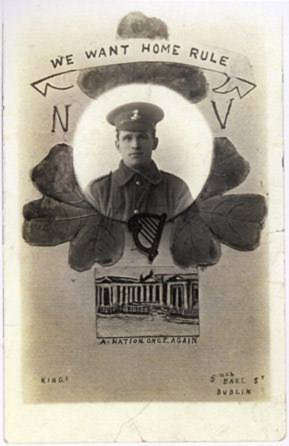
Home Rule card.
Ireland changed drastically in the first quarter of the twentieth century. Initially, land reform was the main concern for most people. Many were caught up in the romantic movement and the surge in nationalism then sweeping Europe, idealizing self-sufficiency and rediscovering national folklore and culture.
On the eve of World War I, Ireland was on the brink of civil war. In the South, the national mood demanded Home Rule – a local parliament answerable to Westminster – which was fiercely resisted by Unionists in the North. This, the dominant issue in Irish politics, was shelved for the duration of the war, but by 1918, the Irish political landscape had been transformed.
The public reaction to the 1916 Rising changed after 16 of the leaders were excuted. The manner of their treatment sparked an intense reaction and when the post-war general election came around, Sinn Féin with its radical ‘independence’ stance, swept the old-world Irish Parliamentary Party from its power-base.
‘All changed, changed utterly,
A terrible beauty was born.’
September 1916, by W.B. Yeats.
The Home Rule issue, deferred by the war, was now superseded by a strong independence movement throughout most of the island. The War of Independence was followed by a highly divisive Civil War and the fledgling Irish Free State, baptized with blood, settled into its new, independent position, but the status of Ireland’s Great War dead and the thousands of veterans remained unclear.